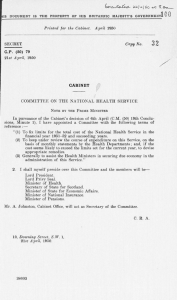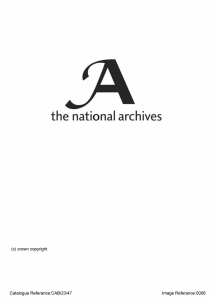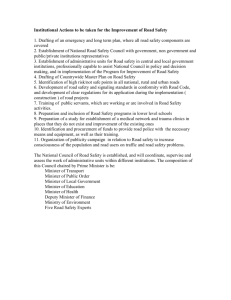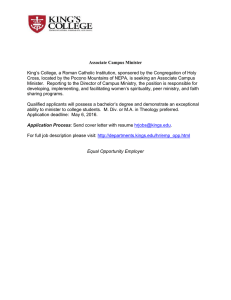Guidelines on Managing Records in a Minister’s Office
advertisement
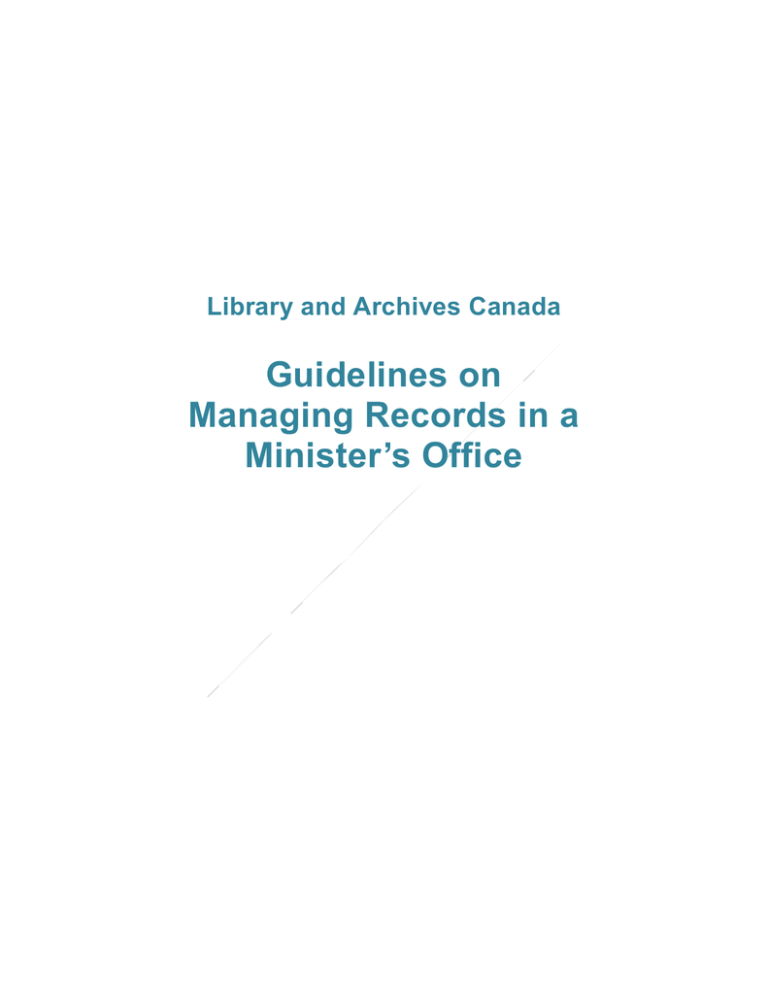
Library and Archives Canada Guidelines on Managing Records in a Minister’s Office Table of Contents Foreword ...................................................................................................... 4 1. Effective Date ....................................................................................... 5 2. Application ............................................................................................ 5 3. Definitions ............................................................................................ 5 4. Context ................................................................................................ 5 5. Purpose ................................................................................................ 6 6. Records in a Minister’s office ................................................................... 6 6.1 Managing Records in a Minister’s office .................................................. 6 6.1.1. Segregation of Records .................................................................... 7 6.1.2. All media and formats ...................................................................... 8 6.1.3. Designated official ........................................................................... 8 6.2. Government Records in a Minister’s Office ............................................... 9 6.2.1. Identification of Government Records ................................................ 9 6.2.2. Responsibilities ............................................................................... 9 6.2.3. Records management ...................................................................... 9 6.3. Ministerial Records .............................................................................. 11 6.3.1. Identification of Ministerial Records ................................................. 11 6.3.2. Responsibilities ............................................................................. 11 6.3.3. Records management .................................................................... 12 6.3.4. Transfer to archives....................................................................... 12 6.4. Personal or Political Records ................................................................. 13 6.4.1. Identification of personal or political Records .................................... 13 6.4.2. Responsibilities ............................................................................. 13 6.4.3. Records management .................................................................... 13 6.4.4. Transfer to archives....................................................................... 14 6.5. Cabinet Documents ............................................................................. 14 6.5.1. Identification of Cabinet documents ................................................. 14 6.5.2. Responsibilities ............................................................................. 15 6.5.3. Records management .................................................................... 15 7. Roles and responsibilities ...................................................................... 15 8. Monitoring, evaluation and review.......................................................... 16 9. Consequences ..................................................................................... 16 10. Information......................................................................................... 16 Appendix A: Related Documents .................................................................... 17 Appendix B: Definitions ................................................................................ 18 Appendix C: Transfer of Personal, Political and Ministerial Records to LAC ........... 20 Foreword “Of all national assets, archives are the most precious; they are the gift of one generation to another and the extent of our care of them marks the extent of our civilization.” Sir Arthur Doughty Dominion Archivist (1904-1935) The records created in ministers’ offices constitute a significant portion of Canadian documentary heritage. They are an integral part of the history of our country. In the Canadian political system, cabinet members play a key role in developing and implementing policies and programs, and in our governance. Library and Archives Canada, Canada’s memory, is the institution responsible for preserving all the records found in federal ministers’ offices, in all the categories combined. It is proposing here a revised version of its publication, Guidelines for Managing Recorded Information in a Minister’s Office (1992). This tool, which includes the most recent information on recordkeeping, provides advice for ministers and their staff to help them manage the records that they create and retain. The preservation of these records will always be a priority for Library and Archives Canada. As stipulated by the preamble of the Act to establish the Library and Archives of Canada, the institution is “a source of enduring knowledge accessible to all, contributing to the cultural, social and economic advancement of Canada as a free and democratic society.” The Guidelines on Managing Records in a Minister’s Office were prepared within this context for the benefit of all Canadians. Library and Archives Canada Guidelines on Managing Records in a Minister’s Office 1. Effective Date These guidelines were approved by the Director General of the Evaluation and Acquisitions Branch and take effect on 19/10/2015. These guidelines superseded and wholly replace the Guidelines for Managing Recorded Information in a Minister’s Office (1992). 2. Application The guidelines were prepared by the Evaluation and Acquisitions Branch of Library and Archives Canada. It is to be read in conjunction with: • Policy on the Security of Cabinet Confidences, 2014 (PCO) • Accountable Government: A Guide for Ministers and Ministers of State (PM) • Guidance Manual – Control and Handling of Cabinet Documents (PCO) • Policy on Information Management, TBS, 2007 • Policies for Ministers’ Offices, TBS, 2011 • Confidences of the Queen's Privy Council for Canada (Cabinet confidences) Additional sources of information regarding Recordkeeping, management, and Government Records may be found in Appendix A. information Record-keepers in the Minister’s office should work closely with those responsible for managing Records and information holdings of their institution – in particular the designated Information Management Senior Official responsible for the implementation of the Policy on Information Management, TBS, 2007. These guidelines apply to actions taken to manage Records in a Minister’s office. 3. Definitions Capitalized terms in these guidelines have the meaning set out in the Library and Archives Canada Act. Additional terms are defined in Appendix B. 4. Context The Library and Archives of Canada Act (LAC Act) mandates Library and Archives Canada (LAC) to “be the permanent repository of publications of the Government of Canada and of government and ministerial records that are of historical or archival value;” further, it states: • • 5. No government or ministerial record […] shall be disposed of, including by being destroyed, without the written consent of the Librarian and Archivist of Canada or of a person to whom the Librarian and Archivist has, in writing, delegated the power to give such consents; The transfer to the care and control of the Librarian and Archivist of government or ministerial records that he or she considers to have historical or archival value shall be effected in accordance with agreements for the transfer of records. Purpose These guidelines provide information on how to efficiently and effectively store, manage, retrieve and dispose of Records created or received in a Minister’s office that continue to be under the control of the office of a Minister, including the segregation of the four types of Records commonly found in that office: Government Records; Ministerial Records; Personal or Political Records; and Cabinet Documents. The purpose of these guidelines is to assist Ministers, their staff, and those responsible for Records and information management in Government Institutions involved in the creation and management of Records in a Minister’s office to manage them. The expectation is that: • The right information, coherent and current, can be found and provided to the Minister in a timely way, to enable decision making, quality service delivery, and to support transparent, accountable, effective and efficient governance; • Information classified in the national interest, and other sensitive information, is protected from unauthorized access and disclosure, and loss of information or its unauthorized use is prevented; • Cohesive and timely response to the requirements of applicable legislation, such as the Access to Information Act, Privacy Act, Canada Evidence Act, Security of Information Act, and Library and Archives of Canada Act is ensured; • The recommended application of these guidelines from the beginning and throughout a Minister’s term will ensure a smooth transfer; • The Documentary Heritage created by a Minister’s office is preserved. 6. Records in a Minister’s office 6.1 Managing Records in a Minister’s office A Minister in Canada’s federal system of government fulfils many roles, each of which requires appropriate information: Minister’s role Information created/acquired … the Minister requires information relating to policy Member of a political matters, caucus affairs, party organization, nominations, party election campaigns, and local party machinery; Constituency representative Parliamentarian Member of the Queen’s Privy Council … the Minister exchanges correspondence with constituents, sends "householders" to constituents, and uses information relating to constituency case work and constituency office operations; … the Minister needs information on the business of the House of Commons , on the views of constituents, the general public, caucus and opposition members, as well as information on the operations of their office on the “Hill" ; … the Minister uses information concerning their responsibilities as head of Government Institution(s), as a member of one or more Cabinet committees, as a member chosen by the prime Minister to carry out regional or other special responsibilities, and day-to-day operations of a Minister’s office. 6.1.1. Segregation of Records The Minister’s multiple roles requires that Records kept in their office be broken down in four categories: Government Records, Ministerial Records, Personal and Political Records and Cabinet documents. These Records must be filed separately for reasons of operating efficiency and confidentiality and to facilitate compliance with statutory requirements. As confirmed by the Supreme Court of Canada (SCC) in Canada (Information Commissioner) v. Canada (Minister of National Defence) – (Prime Minister’s Agenda case), [2011] 2 S.C.R. 306, a Minister’s office is not in and of itself a Government Institution, nor is it part of a Government Institution for purposes of the Access to Information Act (ATIA). Therefore, a Minister’s office is not subject to the ATIA. However, Records found exclusively in a Minister’s office could be deemed to be under the “control” of a Government Institution for purposes of s.4 of the ATIA where the two-step test is satisfied. The two steps are as follows: 1. Do the contents of the Record relate to a departmental matter? 2. If so, could the Government Institution reasonably expect to obtain a copy of the Record? If a Record meets the first step of the test, one must then go on to the second step. The Court stated that the second step of the test is an objective one to be assessed on a review of all relevant factors, including in particular: • • • the substantive content of the Record; the circumstances in which it was created; and the legal relationship between the Government Institution and the Record holder. Only Records that solely relate to non-departmental matters will fail to meet the first step of the test developed by the Supreme Court. Otherwise, whether a Record will meet the second step will need to be assessed on a case by case basis having regard to all relevant facts. 1 In addition, as Treasury Board Secretariat (TBS) provides Ministers with budgets for exempt staff, a budget for operating their offices, and a budget for departmental staff assigned to a Minister’s office, Ministers must be able to differentiate between expenses for activities related to the conduct of their portfolio and other official government business and expenses incurred as members of Parliament and members of a political party. See Policies for Ministers’ Offices, TBS, 2011. 6.1.2. All media and formats Regardless of the medium or form used to create them, the Records in a Minister’s office provide evidence of the activities, decisions and responsibilities undertaken by the Minister in the course of their term of duty; and support the Minister’s transparency and accountability with respect to Parliament and the Canadian public. These may include: • • • • • Textual, photographic and audio-visual Records (both digital and analogue) Information published on-line Social media Records and instant messaging Emails Records on mobile devices. Recordkeeping planning is highly recommended to take place as early as possible in a Minister’s mandate, particularly given the increase in the use of digital records. The information management requirements for digital Records are complex, due to access issues (obsolete file formats and media) and the need to capture and maintain metadata. 6.1.3. Designated official The Minister’s office should identify one person to oversee Records and informationmanagement practices in all locations and on all devices. The Records created or used by a Minister may be held in more than one location (the Minister’s Hill office, the Minister’s departmental office, and a constituency or regional office), and in multiple See (Implementation Report No. 115 - Access to Records in a Minister’s Office - Prime Minister’s Agenda Case, TBS, 2013. 1 mobile electronic devices. Ideally, the designated official and/or their staff should have expertise in information management. The designated official may consider consulting departmental staff responsible for Government Records as a potential resource for information; they may also wish to draw on the expertise available from LAC. For questions concerning training or return of Cabinet Records, the designated official may wish to consult the Operations and Cabinet Papers System Unit of the Privy Council Office (PCO). 6.2. Government Records in a Minister’s Office 6.2.1. Identification of Government Records Government Records may be created or received by either the Government Institution or the Minister. They relate to and support the mandate of the Government Institution. Records which originate from the Minister’s office, sent to the institution and a copy of which is kept in the Minister’s office, are also considered Government Records. 6.2.2. Responsibilities Government Records held in a Minister’s office pending the conclusion of an item of business, are the responsibility of the Government Institution and are to be managed in accordance with Treasury Board Secretariat’s (TBS) Policy on Information Management, TBS, 2007 and related instruments. The Minister, or their designate, is responsible for Government Records in its possession that are responsive to an access to information request received by the Government Institution under the Privacy Act and/or the Access to Information Act. It is important to note that it is an offence under s. 67.1 of the ATIA to destroy, falsify, conceal, etc. a Record with intent to deny a right of access under the ATIA. The Minister, or their designate, is also responsible for ensuring that Ministerial Records can be differentiated from Government Records found in the office of a Minister. 6.2.3. Records management Sound management of Government Records in a Minister’s office includes organizing and classifying the Records in a manner that allows their identification and retrieval in support of the business of the Minister, including responding to ATIP requests. The Minister’s office should return Government Records as soon as it no longer requires them. Until Government Records are returned, the Minister’s office should store them separately. For convenience, the Minister’s office may wish to maintain a complete or partial series of Government Records it creates or receives. Although located in the Minister’s office, these Records are under institutional control. Where the Minister is responsible for multiple institutions and/or portfolio agencies, a means should be in place to allow for easy differentiation and management of Records for each institution. When the Minister’s office adds content to a Government Record, and/or creates background information on a Government Record it would not readily share with the Government Institution, that new Record is a Ministerial Record. The Minister’s office should ensure these two sets of Records remain segregated, and that a means of cross referencing the related Records is in place, such as a numbering system. The Minister's office should also ensure that the annotated portions of Ministerial Records can be readily severed from the original content of the government records upon which they are based. File Classification Scheme As Government Records in a Minister’s office are governed by the informationmanagement requirements of the Policy on Information Management, TBS, 2007, Ministers’ offices are advised to adopt the institution’s classification scheme as the basis of their own classification system for those Records. This one-to-one relationship between classification structures will greatly facilitate the exchange of Records between the Minister’s office and the institution. It may be useful to create a simplified version of the institution’s file classification structure by focusing on the major functions or groups of Records used (note: an institution will usually have a complex classification structure to reflect greater volumes of more detailed information, whereas it is usually only condensed documents or those of a high or aggregated level of detail that are referred to the Minister’s office). If the institutional structure incorporates a system of coding, i.e., numbered documents or files, it may be useful to incorporate those codes or, preferably, the primary element of the code into the Minister’s office classification structure to establish a direct relationship between the institution’s Records and corresponding Records in the office of a Minister. For example, the Minister’s office might adapt an institutional file code such as "4500-3-05/06 (General Administration and Management - Business Planning Coordination, Level 3 Business Plan, Fiscal Year 2005/2006)” as “4500 – General Administration and Management”. Upon changing portfolios or leaving office No government or Ministerial Record shall be disposed of, including by being destroyed, without the written consent of the Librarian and Archivist of Canada (s. 12 LACA). Government Records still being used by the Minister’s office should be returned to the institution. 2 6.3. Ministerial Records 6.3.1. Identification of Ministerial Records Examples of Ministerial Records may include the following types of documents: • • • • • • Records that reflect deliberations by a Minister and exempt staff, or communications between Ministers on policy matters on matters not directly related to a Minister’s portfolio; Records documenting official assignment other than departmental or portfolio duties; Any document relating to cabinet confidences not part of the cabinet paper system; Records concerning administrative matters that pertain only to the Minister’s duties or office (as opposed to as head of a GC institution); Copies of Government Records and other sources that help to present a complete picture of the subject concerned and that are therefore annotated and retained in or integrated into Ministerial Records by the Minister or exempt staff; and, Records from the prime Minister which are outside of the Minister’s current portfolio but may be expected to lead to the creation of new institutions or additional responsibilities being assigned to existing institutions. 6.3.2. Responsibilities The Minister, or their designate, is responsible for ensuring that Ministerial Records are well managed. The Minister, or their designate, is also responsible for ensuring that Ministerial Records can be differentiated from Government Records found in the office of a Minister. The Minister, or their designate, is responsible for providing Government Records in its possession that are responsive to an access to information request received by the Government Institution under the Privacy Act and/or the Access to Information Act. Although the designation of a Record as a Ministerial or Government Record may be a factor to be taken into account, ultimately the two-part test set out by the Supreme Court of Canada will be applicable to such Records and will determine whether any of them are subject to the Access to Information Act or Privacy Act. See Accountable Government: A Guide for Ministers and Ministers of State, p. 30. Please note that duplicates must be retained if responsive to an ATIA/PA request. 2 6.3.3. Records management Sound management of Ministerial Records includes organizing and classifying the Records in a manner that allows their identification and retrieval in support of the business of the Minister. Ministerial Records should be stored in a way that ensures their integrity, protection, and security. Ministerial Records should be kept distinct from other types of Records in the Minister’s office. This can best be accomplished by creating and maintaining a separate series for Ministerial Records, through the use of metadata tagging, or by physically segregating the paper Records from government, Cabinet and Personal and Political Records before transfer to LAC. File Classification Scheme While infrequent, if a Ministerial Record is created in relation to a Record which originated as a Government Record, the simplest means of identifying and cross referencing such Ministerial Record to the Government Institution’s file would be to keep the same file number, but by adding an “M” to the beginning of the file to specifically identify it as “Ministerial” • • Government file classification: 4500-3-05/06 (General Administration and Management - Business Planning Coordination, Level 3 Business Plan, Fiscal Year 2005/2006) Ministerial file classification: M4500-3-05/06 (General Administration and Management - Business Planning Coordination, Level 3 Business Plan, Fiscal Year 2005/2006) However, as a Ministerial Record will often concern a function which may not be included in the Government Institution’s file classification scheme, a separate, or expanded system is regularly needed. While classifying Records according to their subject used to be a common practice, current best practices of experts around the world base classification on a rigorous analysis of business functions and activities. A function-based approach anchors information and Records classification firmly in business processes and activities. If desired, the Minister’s office may consult the Government Institution’s Information Management Team for advice on setting up segregated systems for each category of information. Upon changing portfolios or leaving office Under the Library and Archives Canada Act, no Government or Ministerial Record shall be disposed of, including by being destroyed, without the written consent of the Librarian and Archivist of Canada. To inquire about the disposition of Ministerial Records at any time during the Minister’s tenure or when the Minister leaves office, the Minister’s office should contact LAC. 6.3.4. Transfer to archives LAC identifies those Ministerial Records which have archival or historical value, specifies how and when these archival Records may be transferred to LAC, and specifies the conditions of access to transferred Ministerial Records. Normally, access would be limited, for a specified period, to the Minister and persons authorized by the Minister. For additional information on how transfers are effected, see Appendix C. LAC recommends specific file formats and transfer guidelines for digital Records; see the LAC Guidelines on File Formats for Transferring Information Resources of Enduring Value. LAC can provide further advice on many issues related to digital Records. 6.4. Personal or Political Records 6.4.1. Identification of personal or political Records Examples of Personal or Political Records include: • • • The Minister’s constituency business and work as a member of Parliament; Party political matters, including elections and leadership races, party organization, and caucus affairs; Records relating to the private life or personal interests of the Minister. 6.4.2. Responsibilities As Personal and Political Records are considered a Minister’s private property, the Minister’s office staff are responsible for the identification of Personal and Political Records and for identifying which ones may be suitable for future donation to LAC. 6.4.3. Records management Personal or Political Records are neither subject to the right of access under the Access to Information and Privacy Acts nor Records disposition provisions of the Library and Archives of Canada Act. They should be stored separately from government, Cabinet, and Ministerial Records. Digital Personal or Political Records should be stored on separate sub-directories of the Minister’s drive or server, or printed out and maintained with the paper series of Personal or Political Records. File Classification Scheme As a Government Institution’s classification system is not suitable for a Minister’s Personal and Political Records. The Minister’s office should adopt its own classification system; it may consult the Government Institution’s Information Management Team for advice on setting up a segregated system. Upon changing portfolios or leaving office Personal or Political Records are the private property of a Minister. Therefore, the Minister, or their designate, should determine how to manage them upon changing portfolios or leaving office. Ministers may wish to consult LAC regarding the possible use of secure storage facilities offered by LAC. 6.4.4. Transfer to archives As private Records, all personal or political Records belong to the Minister. Such Records are theirs to dispose of as they please. Over the years, many Ministers have chosen to donate these Records to LAC. LAC is actively engaged in encouraging these donations that contribute to the building of national memory. LAC will accept analogue or digital Records with a particular interest in receiving accompanying basic file indexes. In the case of digital Records, minimum metadata must be provided in order to access the Records. LAC recommends specific file formats and transfer guidelines for digital Records; see the LAC Guidelines on File Formats for Transferring Information Resources of Enduring Value. LAC can provide further advice on many issues related to digital Records. To make a donation, please contact: Library and Archives Canada, Contact Centre 550 de la Cité Boulevard Gatineau, Québec K1A 0N4 Telephone 819-934-7519 or 1-866-498-1148 centre.liaison.centre@bac-lac.gc.ca. For additional information on how transfers are effected, see Appendix C. For information on donating personal and political Records of archival value contact the Canada Revenue Agency. 6.5. Cabinet Documents Cabinet Documents are managed by the PCO Cabinet Papers System Unit (CPSU) and are part of the Cabinet Papers System. A summary of selected portions of these documents has been provided below; however, for detailed instruction and information on managing Cabinet Documents the PCO documents should be consulted directly. 6.5.1. Identification of Cabinet documents The Guidance Manual – Control and Handling of Cabinet Documents prepared by the PCO Cabinet Papers System Unit (CPSU) provides specific information for Minister’s offices on how to manage, distribute and keep secure Cabinet documents. 6.5.2. Responsibilities The efficient operation of the Cabinet and the necessary confidentiality of Ministerial discussions depend, in part, on the proper handling of Cabinet documents. Ministers ensure that Cabinet documents provided to them are safeguarded in accordance with the security requirements set by PCO or, for Cabinet documents related to the Treasury Board, by TBS. While the Minister, or their designate, is responsible for the proper handling and security of any Cabinet documents in their office, any/all inquiries for accessing Cabinet documents should be directed to, and handled by, PCO. 6.5.3. Records management The Guidance Manual – Control and Handling of Cabinet Documents prepared by the PCO Cabinet Papers System Unit (CPSU) provides specific information for Minister’s offices on how to manage, distribute and keep secure Cabinet documents. Ministers, or their designate, assign members of their staff responsibility for controlling the flow and ensuring the security of Cabinet documents. It should be noted that a Record containing Cabinet confidences that is not a Cabinet document is either an institutional Record (if it originated with the institution), or a Ministerial Record (if it originated with the office of the Minister, for example, a briefing note containing political advice to a Minister regarding a Cabinet matter) and should be treated accordingly. Upon changing portfolios or leaving office When a Minister leaves office, any Cabinet documents remaining in the office are managed in accordance with the Guidance Manual. 7. Roles and responsibilities Library and Archives Canada is responsible for these guidelines and for providing additional advice to Minister’s offices on recordkeeping and information management as requested. Shared Services Canada has a service level agreement in place with some Minister’s offices for electronic storage of records managed in a Minister’s office. Office of the Privy Council is responsible for the management of cabinet documents. Treasury Board of Canada Secretariat is responsible for policy on government records and information management. 8. Monitoring, evaluation and review The LAC section responsible for the records of Ministers will review these guidelines to assess their effectiveness every 4 years, or as needed preceding an election year, following the date it comes into effect. 9. Consequences Consequences may result from non-compliance, inadequate risk management, or poor results. Consequences may include the destruction of records of archival value in a minister’s office; the loss of ready availability and reliability of information in a minister’s office resulting in the inability to make decisions, and provide quality, transparent, accountable, effective and efficient government; the inadequate protection of classified and personal information; and non-compliance with federal legislation on access to information, privacy, and security of information. 10. Information Please address any questions about this Guideline to: Director of Economic, Security and Governance Division Library and Archives Canada 550 de la Cité Boulevard Gatineau, Québec K1A 0N4 Please address any general questions regarding the transfer of records to LAC to: Contact Centre Library and Archives Canada 550 de la Cité Boulevard Gatineau, Québec K1A 0N4 Telephone 819-934-7519 or 1-866-498-1148 centre.liaison.centre@bac-lac.gc.ca Appendix A: Related Documents Legislation Access to Information Act, 1985 Canada Evidence Act, 1985 Library and Archives of Canada Act, 2004 Privacy Act, 1985 Security of Information Act, 1985 Policies Policy on Information Management, TBS, 2007 Accountable Government: A Guide for Ministers and Ministers of State, PCO, 2011 Policies for Ministers’ Offices, TBS, 2011 Policy on the Security of Cabinet Confidences, PCO, 2014 Confidences of the Queen's Privy Council for Canada (Cabinet confidences), TBS Reports Implementation Report No. 115 - Access to Records in a Minister’s Office - Prime Minister’s Agenda Case, TBS, 2013 Appendix B: Definitions The following definitions supplement those provided in the Act for the interpretation of these guidelines. Acquisition [Acquisition] Acquisition is the process of acquiring documentary heritage of historical or archival (enduring) value. Acquisition takes place when a decision is made to preserve information resources for future generations, and subsequently to buy, assume ownership, take possession, and/or assume responsibility for stewardship, of information resources for the purpose of preserving them. Care [Garde] Legislated or contractual obligation to protect Documentary Heritage. Control [Responsabilité] The right to manage, preserve and facilitate access to holdings. This includes the authority to make a decision about the maintenance, keeping, care, preservation or security of a Record and how to facilitate access to the Record. Cultural property [Biens culturels] Any object included in the Control List designated by Canada as being of importance for archaeology, prehistory, history, literature, art or science (s. 38 Cultural Property Export and Import Act, R.S.C., 1985, c. C-51). Custody [Possession] The physical possession of material. It does not require control or ownership. Disposition authorities [Autorisations de disposer] The instruments that enable government institutions to dispose of records which no longer have operational value, either by permitting their destruction (at the discretion of institutions), by requiring their transfer to Library and Archives of Canada, or by agreeing to their alienation from the control of the Government of Canada. Historical or Archival Value [Valeur continue] Historical or archival (enduring) value is the quality of having continuing usefulness or significance to Canadian society. Information resources [Ressources documentaires] Any documentary material produced in published and unpublished form regardless of communications source, information format, production mode or Recording medium. Information resources include textual Records (memos, reports, invoices, contracts, etc.), electronic Records (e-mails, databases, internet, intranet, data etc.), new communication media (instant messages, wikis, blogs, podcasts, etc.), publications (reports, books, magazines), films, sound Recordings, photographs, documentary art, graphics, maps, and artefacts. Metadata [Métadonnées] Information used to contextualize, manage, preserve and provide access to documentary heritage. Administrative metadata [Métadonnées administratives] Information that facilitates both short-term and long-term management and processing of holdings, which includes the following: • technical data on creation and quality control • rights management, access control and use requirements • preservation action information, such as information or data on copying or treatment. Personal or Political Records [Documents personnels ou politiques] Records that relate to Parliament, party and political matters and to the Minister’s personal life. Retention period [Délai de conservation] The amount of time a record must be kept to meet administrative, fiscal, legal or historical requirements. Appendix C: Transfer of Personal, Political and Ministerial Records to LAC In addition to Government Records, Library and Archives Canada (LAC) is mandated to ensure that personal, political and Ministerial Records of national and historical significance are preserved for the use of present and future generations of Canadians. As political, personal and Ministerial Records are not deemed Government Records, they are not transferred to LAC automatically, but are transferred to LAC by the Minister, or their designated staff. Deposit Service versus Formal Acquisition of Records: As Ministers have legal responsibilities to protect any cabinet confidences that may be found amongst Ministerial Records, and ethical responsibilities to protect personal and political information found amongst the Records in their office, it is important to note the two distinct services offered by LAC during the transfer of such Records, and the differences between LAC’s deposit service and the potential future formal acquisition of material. Deposit Service: LAC’s deposit service is free and part of LAC’s mandate. When a Minister changes portfolios, or retires, they may face the difficult questions of what to do with Records which have accumulated during their tenure in office. LAC’s deposit service is a reflection of these imperatives, as it allows us to provide secure storage and preservation facilities to ensure the safety and provenance of Records during transitory periods. The Records are stored in sealed climate-controlled vaults to which only authorized staff has access. Security and secrecy of Records are assured. The Records remain the property of the Minister, who alone can authorize access to them, or remove them at will whenever and to wherever they wish However, while LAC offers our deposit service to ensure the integrity and preservation of Records, LAC does not normally formally acquire personal, political or Ministerial Records immediately, but will typically acquire material once a Minister has been retired for a period of at least five years. It is not uncommon for a Minister to deposit material with LAC every time they change Ministerial portfolios, thus resulting in many different deposits with LAC over the course of their career. Once a Minister has retired and made any final deposits of material, LAC examines the multiple deposits as a whole, and considers the material for potential acquisition. Formal Acquisition of Records by LAC: LAC will not generally acquire a politician’s Records before at least five years after the end of their career. If a Minister retires but continues to create Records of potential national significance in their new position (i.e. political activist, author etc.), LAC will often wait to seek to acquire any of their political Records at the same time as any of their post-political Records. Once an appropriate period has passed and LAC has examined and identified material of interest for formal acquisition, LAC then contacts the former Minister to inquire if they are ready and willing to formally donate their material to LAC through a formal Deed of Gift. Once a Deed of Gift is signed, the processing of the Records begins. Once the processing is completed, appropriate access recommendations will be made by LAC and finalized in cooperation with the Minister, or their designate, to ensure that any/all of their access concerns are taken into consideration.
